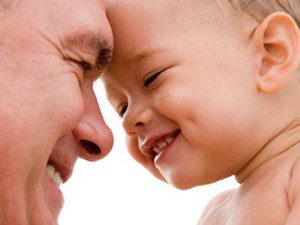June 5, 2019
A new Duke University study finds that, by six to nine months, babies can already recognize that the meanings of some words, such as “car” and “stroller,” are more alike than other words, such as “car” and “juice.”
“Even though there aren’t many overt signals of language knowledge in babies, language is definitely developing furiously under the surface,” said Dr. Elika Bergelson, assistant professor of psychology and neuroscience at Duke University.
To test word comprehension, the researchers brought babies and their caregivers into a lab equipped with a computer screen and few other infant distractions. The babies were shown pairs of images that were related, like a foot and a hand, or unrelated, like a foot and a carton of milk. For each pair of images, the caregiver (who couldn’t see the screen) was prompted to name one of the images while an eye-tracking device followed the baby’s gaze.
The results show that babies spent more time looking at the image that was named when the two images were unrelated than when they were related.
“Even in the very early stages of comprehension, babies seem to know something about how words relate to each other. And already by six months, measurable aspects of their home environment predict how much of this early level of knowledge they have. There are clear follow-ups for potential intervention work with children who might be at-risk for language delays or deficits,” said Bergelson.
“They may not know the full-fledged adult meaning of a word, but they seem to recognize that there is something more similar about the meaning of these words than those words,” she said.
Next, Bergelson wanted to study how babies’ performance in the lab might be tied to the speech they hear at home. To do this, she sent each caregiver home with a colorful baby vest rigged with a small audio recorder and asked them to use the vest to record day-long audio of the infant. She also used tiny hats equipped with lipstick-sized video recorders to collect hour-long video of each baby interacting with his or her caregivers.
By studying the recordings, the research team categorized and tabulated different aspects of speech the babies were exposed to, including the objects named, what kinds of phrases they occurred in, who said them, and whether or not objects named were present and attended to.
“It turned out that the proportion of the time that parents talked about something when it was actually there to be seen and learned from correlated with the babies’ overall comprehension,” said Bergelson.
For example, if a parent says, “here is my favorite pen,” while holding up a pen, the baby might learn something about pens based on what they can see. In contrast, if a parent says, “tomorrow we are going to see the lions at the zoo,” the baby might not have any immediate clues to help them understand what lion means.
“This study is an exciting first step in identifying how early infants learn words, how their initial lexicon is organized, and how it is shaped or influenced by the language that they hear in the world that surrounds them,” said Dr. Sandra Waxman, a professor of psychology at Northwestern University who was not involved in the study.
“My take-home to parents always is, the more you can talk to your kid, the better,” Bergelson said. “Because they are listening and learning from what you say, even if it doesn’t appear to be so.”
The findings are published in the Proceedings of the National Academy of Sciences.





